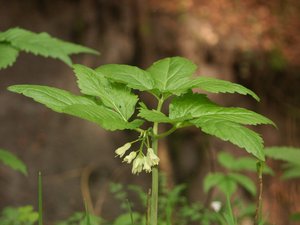Whorled tooth root
| Whorled tooth root | ||||||||||||
|---|---|---|---|---|---|---|---|---|---|---|---|---|

Whorled tooth root ( Cardamine enneaphyllos ) |
||||||||||||
| Systematics | ||||||||||||
|
||||||||||||
| Scientific name | ||||||||||||
| Cardamine enneaphyllos | ||||||||||||
| Crantz |
The whorled tooth root ( Cardamine enneaphyllos ), also known as nine- leaf tooth root , white tooth root or white sanicle , is a member of the cruciferous family (Brassicaceae). It mainly blooms from March to April.
description
The perennial herbaceous plant reaches a height of about 20 to 30 cm. The stem leaves are arranged whorled and usually appear in threes. The feathers are oval-lanceolate and double-serrated irregularly. The pale yellow or almost white, four-fold flowers are nodding. The petals are 12-16 mm long and barely rise above the stamens. The upright pods are 40-75 mm long and 3.5-4 mm wide.
The species has chromosome number 2n = 52-54 or 80.
Occurrence
The lime-loving plant prefers fresh deciduous forests (beech forests) and tall herbaceous vegetation of the colline and submontane level as a location . In Central Europe it is a character type of the Dentario-enneaphylli-Fagetum or the Cardamino-trifoliae-Fagetum and is a Fagion association character.
distribution
The plant only grows sporadically in northern Europe and is found here as far as south-west Scotland and southern Scandinavia. In the west the distribution area extends to central France, in the south to Greece. The plant can be found eastwards as far as Ukraine and the Crimean peninsula. In Germany and Austria, the whorleaved toothroot is widespread in the eastern Alpine region up to the Alpine foothills , in Switzerland mainly in the southern Alps (southern Ticino) and in the Zurich Oberland as far as the Rhine Valley. Along the German-Czech border in Germany there is a patchy distribution area from the Bavarian Forest over the Franconian Alb to Saxony . There are also few occurrences in close proximity in Baden-Württemberg in the Swabian-Franconian forest mountains .
Others
The plant has a rhizome with tooth-shaped leaf scars. According to the principle of "similia similibus curentur" (similar things are cured by similar things), the herb was a popular remedy for toothache in earlier centuries, but also for coughs and fractures and internal wounds. The plants are no longer used in pharmacy today. It is sometimes confused with the forest sanicle .
Common names
For the Quirlblättrige Zahnwurz (also yellow nine-leaved Zahnwurz) exist or existed also the other German-speaking common names : Bergsanikel ( Switzerland ), Grimmwurz ( Silesia ), White Hazelwort (Silesia), Sanikl ( Bavaria , Zillertal ), (White) Scharnikel ( Carinthia , Tirol near Lienz ) and wild mustard ( Austria , Switzerland).
swell
- ↑ a b Erich Oberdorfer : Plant-sociological excursion flora for Germany and neighboring areas . 8th edition. Stuttgart, Verlag Eugen Ulmer, 2001. Pages 462–463. ISBN 3-8001-3131-5
- ^ Franz von Bruchhausen et al. (Ed.): Hager's handbook of pharmaceutical practice. Volume 6: Rudolf Hänsel et al. (Ed.): Jungs P - Z. Springer, Berlin et al. 1994, ISBN 3-540-52639-0 , p. 596.
- ^ Georg August Pritzel , Carl Jessen : The German folk names of plants. New contribution to the German linguistic treasure. Philipp Cohen, Hannover 1882, page 132. ( online ).
- ↑ Heinrich Marzell : Dictionary of German plant names. Volume 2, p. 80 f.
Web links
- Whorled tooth root. In: FloraWeb.de.
- Distribution map for Germany. In: Floraweb .
- Thomas Meyer: Data sheet with identification key and photos at Flora-de: Flora von Deutschland (old name of the website: Flowers in Swabia )

